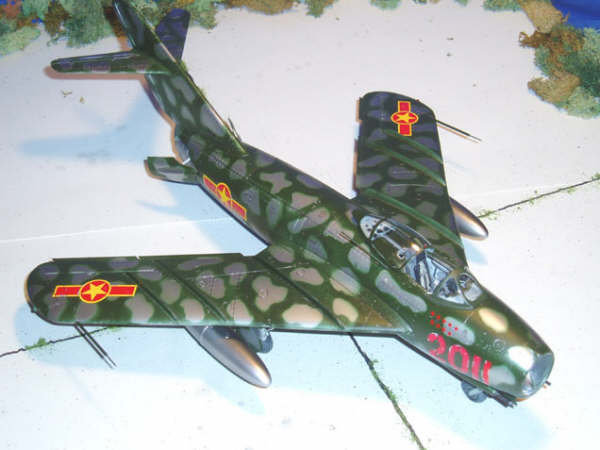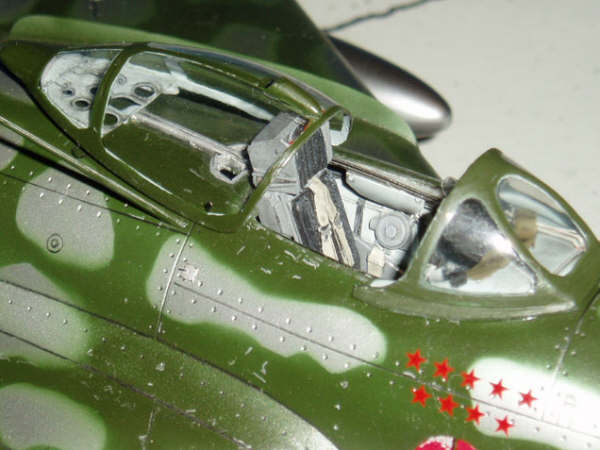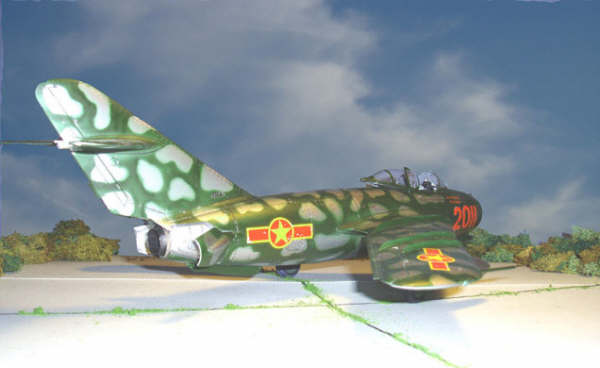|
Hobbycraft's
1/32 scale
MiG-17F
by Scott Jeffery
 |
|
MiG-17F |

Hobbycraft's 1/32 scale MiG-17F is available
online from Squadron
The MiG-17 was designed to rectify some of the
MiG-15s unsatisfactory high speed handling characteristics. The
fuselage was lengthened and a new compound “sickle” wing with no less
than three wing fences was added to help with high speed stability.
Later, an improved engine with afterburner was added to make the
MiG-17F.
The MiG-17 served with at least 22 different Air
Forces around the world and was valued for its ruggedness, simplicity,
outstanding dogfight maneuverability, and the hitting power of its
cannon armament. It gained its greatest fame in the skies over Vietnam
where it was opposed by more sophisticated supersonic American
aircraft. As the war went on, the North Vietnamese were able to
coordinate MiG-17s with supersonic MiG-21s, SAMs, and antiaircraft guns
into a formidable air defense system.

The MiG-17 was typically used at low altitude to
engage bomb laden fighter bombers as they popped up for bombing runs or
as they recovered from their dives. If threatened, MiG-17s would often
form a defensive circle to cover each others’ vulnerable rear
quadrants. If any American aircraft attacked a MiG in the circle, the
other MiGs could use their maneuverability to break across the circle
and attack the American fighter.
This kit is the Hobbycraft copy of the Trumpeter
MiG-17 kit in 1/32 scale. I basically worked on it for two years, on
and off, before completing it. The kit required A LOT of tender loving
care, with many inaccuracies needing to be corrected. Once completed,
however, it makes an impressive model that will look great next to my
new F-105! Some of the items that were scratch built included:
-
ejection seat head
rest (I adapted a MiG-15 seat, the Cutting Edge seat was unavailable
at that time)
-
ventral strake was
added
-
tail warning radar and
position light were added
-
pitot tubes were
fabricated from pins and brass tube
-
canopy rear view
mirror
-
cannon barrels made
from brass and aluminum tube
-
landing light using a
MV lense and Eduard photo etch
-
trim tabs
-
flare launcher
-
drop tank pylons
-
position lights on the
wing tips
Additionally, a number of aftermarket products were
used in construction of the kit. Do not attempt to build this kit
without the Eduard photo etch set (#32-051) or the Squadron crystal
clear canopy (for the MiG-15). These sets replace some of the
components that were pretty sad. Other aftermarket items included:
Various decals from Eagle
Strike’s Fresco collection #32019 and Trumpeter BORT numbers
Cutting Edge intake
splitter (this is also HEAVY…keeps the kit from being a tail sitter,
but fill in the landing light) #32052
Cutting Edge wheels
#32036
Cutting Edge cockpit set
#32101 (this is the actual MiG-17 set with the KK-2 seat)
Problem Areas
Some of the panel lines on the right side of the
tail were wrong, these were filled and re-scribed.
The engine is a VK-1 from an early MiG-17A or a
MiG-15. The VK-1F from the MiG-17F has an afterburner that swells the
combustion chamber noticeably. Don’t use the engine.
Additionally, the engine exhaust nozzle is
incorrect, use the Eduard set to make one.

The location holes for the drop tanks are grossly
out of position and are splayed out (pigeon toed). They need to be
relocated approximately in line with the center wing fences.
The radio antennae on the right side of the
fuselage is in the wrong place….drill a new locating hole.
The wing fences are way too thick, sand them down.
The airbrake hydraulic actuators attach to the
fuselage in the wrong place. New holes were drilled.
Model. Images and Text Copyright © 2005
by Scott Jeffery
Page Created 16 February, 2005
Last Updated
16 February, 2005
Back to
HyperScale Main Page
|
Home
| What's New |
Features |
Gallery |
Reviews |
Reference |
Forum |
Search